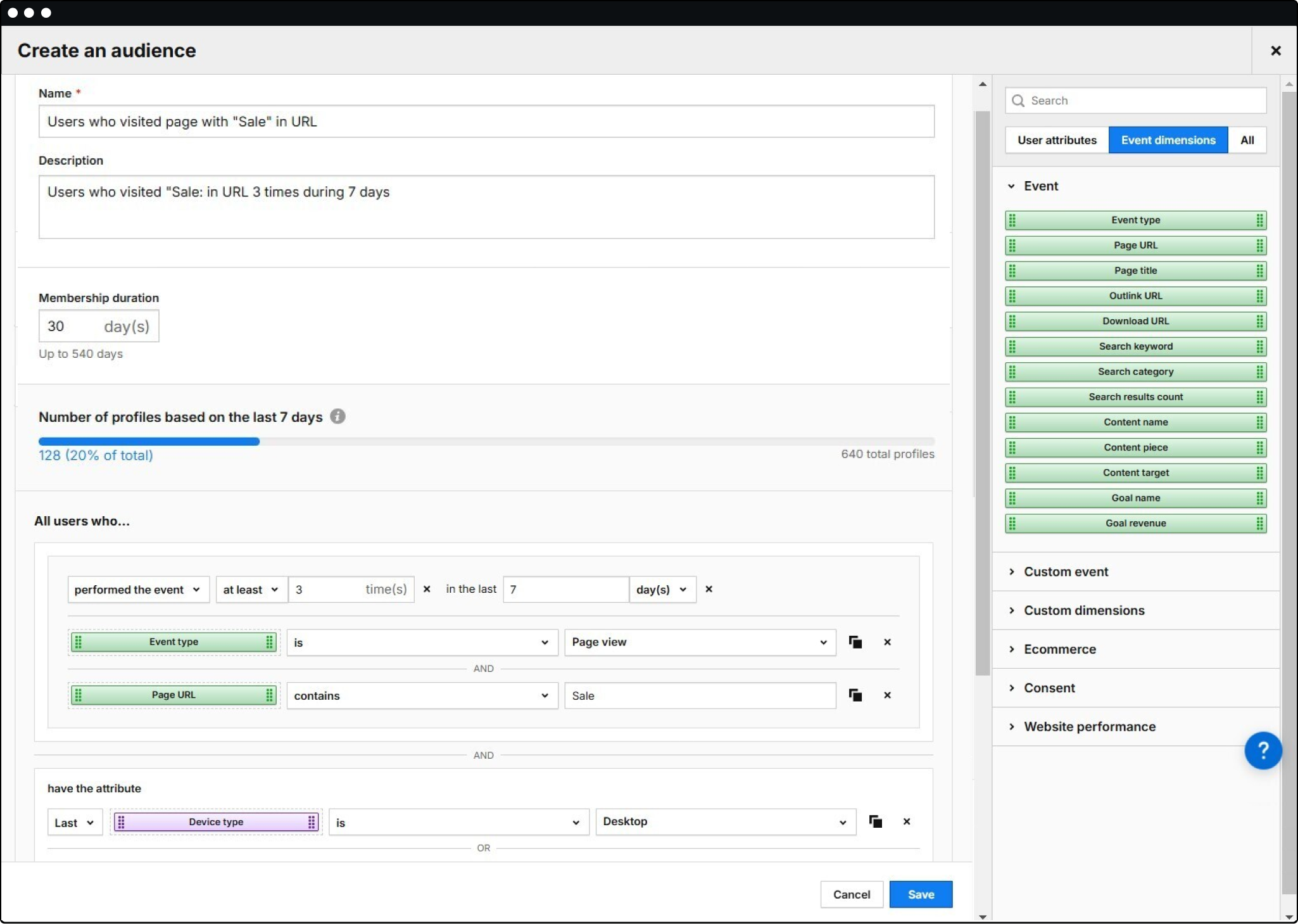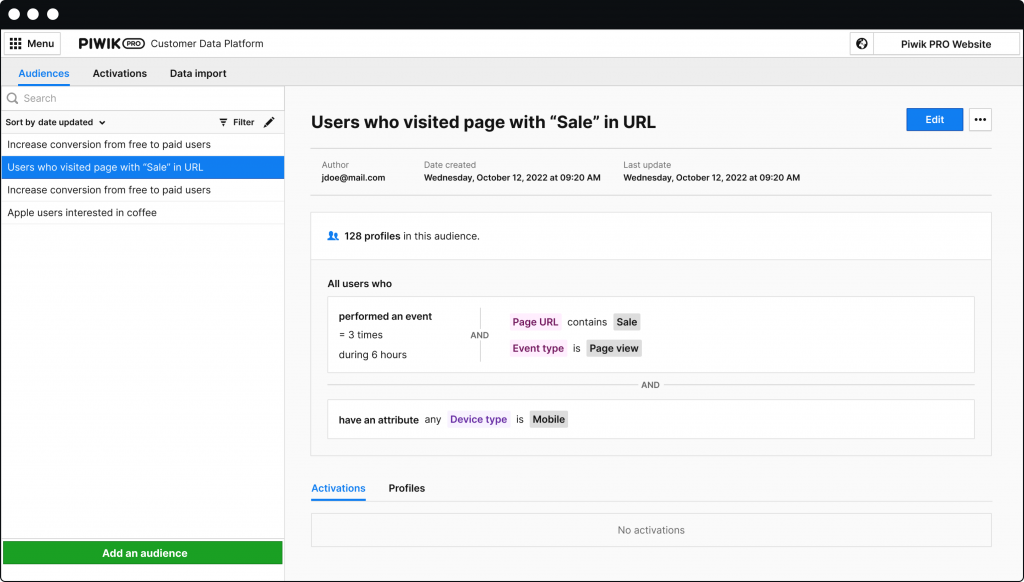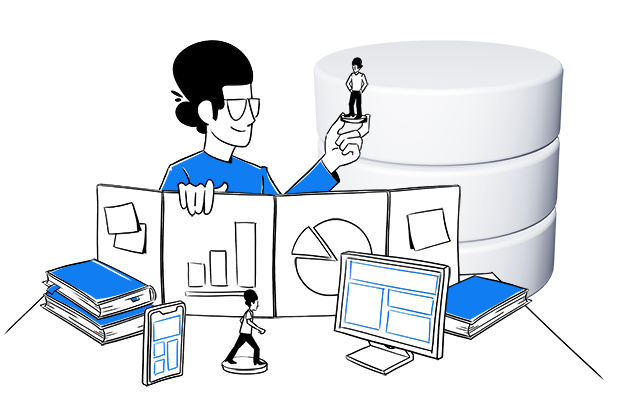Note: This article references our Customer Data Platform, now called Data Activation.
In the second episode of our Masterclass for marketers series, organized in collaboration with Timo Dechau from deepskydata, our experts dive into the topic of data activation in marketing.
Arpit Choudhury, data strategy expert and CEO at databeats and Glenn Vanderlinden, co-founder at Human37, explain how to activate data with the Piwik PRO customer data platform (CDP) to drive actions and campaigns that lead to meaningful insights, improved experiences, and business growth. Their advice proves that data activation is an essential component of data-driven decision-making in organizations.
Let’s discover the key tips our experts recommend to build personalized customer experiences.
What is data activation
Data activation refers to leveraging collected data to generate actionable insights and drive specific outcomes within an organization. This process involves transforming raw data into valuable insights and using them to make informed decisions, improve operational efficiency, enhance customer experiences, or drive business growth. It is a critical component of a data-driven organization, enabling it to unlock the full potential of its data assets and drive meaningful business outcomes.
Activation is not just about moving data – it’s about running experiments with it or doing anything else where you’re personalizing user experience. But also, it’s not just about personalization. You’re using the data to offer a better experience to the user. And that’s what data activation is.
Arpit Choudhury, data strategy expert and CEO at databeats
Data activation entails:
- Running tests or campaigns: Activation involves using data to conduct real-time experiments or campaigns, leveraging data analysis insights to inform decision-making and drive actions.
- Building audiences: It can also involve building audience segments based on data properties and events – an initial step for targeted activations or personalized experiences.
- Improving customer experience: Data activation aims to improve customer experiences by implementing changes, such as optimizing a website’s elements, adjusting product filters, or personalizing user experience.
- Deriving insights: Activation is also about deriving more insights from data. By activating data through experiments or campaigns, organizations can gain deeper insights into user behavior, preferences, and the effectiveness of different strategies.
- Repetitive processes: Data activation is an iterative process where insights gained from previous activations inform future actions and experiments, creating a continuous improvement cycle.
- Holistic approach: Activation encompasses various stages, including data collection, analysis, insight generation, experiments, and measurement of outcomes. It involves cross-functional collaboration processes to leverage data for organizational growth and improvement.
What are the main obstacles to data activation
There are a few obstacles that may occur while activating data. Addressing them requires strategic planning, investment in resources and infrastructure, cross-team collaboration, and a clear understanding of the goals and outcomes of data activation efforts.
One of the challenges is the perception of the value of data analytics and the difficulty in quantifying the return on investment (ROI). Some organizations may struggle to allocate a budget for analytics, preferring to invest in other areas where ROI is more immediately apparent.
Also, many organizations need to invest more in building a solid foundation for data, which includes collecting the right data, ensuring its quality, and making it available for activation. There may be a misunderstanding of what activation entails. It’s not just about moving data, but also about running experiments or campaigns using it to provide a better customer experience.
Measuring the outcomes of data activation efforts is crucial to determine if they have improved customer experience or led to growth. This requires cross-team collaboration and a solid setup for measuring outcomes. Teams may need more support, including resources, tools, and expertise. Effective data activation and measuring its impact can be challenging without adequate assets.
While revenue growth is significant, it’s also essential to consider other outcomes of data activation, such as increased efficiency or higher customer satisfaction. Focusing only on revenue may overlook other valuable aspects of your business.
Finally, it’s important to remember that data activation isn’t just about acquiring new users – it’s also about ensuring that existing customers continue to use and derive value from the product or service. This requires ongoing engagement strategies informed by data.
Activate your data with the customer data platform from Piwik PRO
Our experts gave a step-by-step guide on how to activate data with Piwik PRO. By following these rules, you can make the most out of the collected data, which means targeting specific audiences and customizing their experiences based on their behavior and preferences.
Piwik PRO allows you to create an audience and use it as a trigger – it’s a powerful feature. In other platforms, you have to do a lot of work to configure the specific data layer. Here, a UI lets you do it, which is a mega plus.
Glenn Vanderlinden, co-founder at Human37
Define the audience
Start by defining the audience you want to target for activation and define the needed criteria. Create rules to filter users based on their behavior, such as page titles containing specific keywords. Optionally, you can set up exclusion criteria to exclude particular users.

Implement triggers
Set up triggers to detect when users meet the criteria defined for the audience. Triggers can be based on user behavior, such as visiting specific pages or engaging with certain content.
Manage consent
Ensure that data collection and activation processes comply with relevant privacy regulations by incorporating consent management. Associate data collection and activation with appropriate consent categories, such as personalization or marketing automation, depending on how the data will be used.
Customize user experience
Use JavaScript code to customize the user experience based on the defined audience. For example, add a navigation item for users who meet the audience criteria.

Track performance
Implement tracking mechanisms to monitor the performance of the activation strategy. This could include tracking impressions and click-through rates (CTR) for the customized user experience elements.
Test and iterate
Test the implementation in a controlled environment to ensure everything works as expected. Continuously monitor and analyze the data to refine audience definitions and activation strategies based on insights gathered from performance metrics.
Enrich your audience data with Piwik PRO
Enriching your audience with Piwik PRO involves a strategic approach that integrates various components to optimize data activation while prioritizing privacy and compliance. You can extend data activation possibilities to numerous destinations through webhooks and automation tools, such as CRM platforms, email marketing tools, and ad platforms.
For more details about activating data, read our articles:
- What is data activation and how does it fit into your data analytics stack
- Customer Data Platform: Generate meaningful insights with customer data activation and import
- 8 customer data platform (CDP) use cases that will drive your business growth
Watch the full episode and learn how to activate data with Piwik PRO CDP













